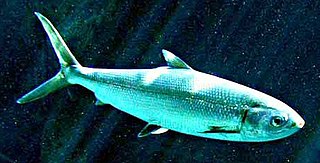
The Gonorynchiformes are an order of ray-finned fish that includes the important food source, the milkfish, and a number of lesser-known types, both marine and freshwater.

The milkfish is a widespread species of ray-finned fish found throughout the Indo-Pacific. It is the sole living species in the family Chanidae, and the only living member of the genus Chanos. The repeating scientific name (tautonym) is from Greek khanos.

Chanidae is a family of fishes which has a number of fossil genera and one monotypic extant genus which contains the milkfish.

Gonorynchus is a genus of long thin gonorynchiform ray-finned fish, commonly called beaked salmon or beaked sandfish. They live on sandy bottoms near shorelines of the temperate & subtropical Southern Hemisphere and East Asia. There are five known extant species which are placed in this genus. All have a distinctive angular snout that the fish use to dig themselves into the sand. A swim bladder is absent.
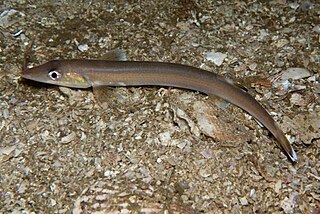
Gonorynchidae is a family of ray-finned fish in the order Gonorynchiformes, which has a number of fossil taxa and one extant genus, Gonorynchus, the beaked salmons. They are an ancient group, with fossils known from as far back as the Albian stage of the Early Cretaceous.
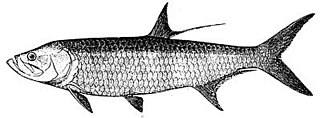
The Elopiformes are the order of ray-finned fish including the tarpons, tenpounders, and ladyfish, as well as a number of extinct types. They have a long fossil record, easily distinguished from other fishes by the presence of an additional set of bones in the throat.
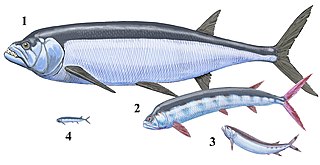
Ichthyodectiformes is an extinct order of marine stem-teleost ray-finned fish. The order is named after the genus Ichthyodectes, established by Edward Drinker Cope in 1870. Ichthyodectiforms are usually considered to be some of the closest relatives of the teleost crown group.
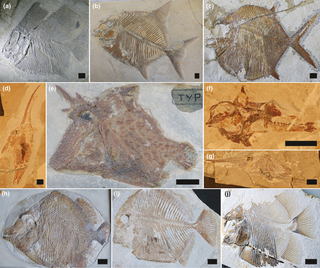
Pycnodontiformes is an extinct order of primarily marine bony fish. The group first appeared during the Late Triassic and disappeared during the Eocene. The group has been found in rock formations in Africa, Asia, Europe, North and South America.

The Kneriidae are a small family of freshwater gonorhynchiform fishes native to sub-Saharan Africa.
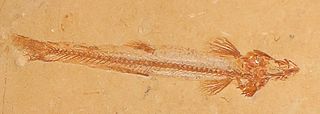
Charitopsis is an extinct genus of prehistoric marine ray-finned fish that lived during the lower Cenomanian. It was a relative of modern beaked salmons. It contains a single species, C. spinosus from the Sannine Formation of Lebanon. It is possibly related to the sympatric gonorynchid Charitosomus, although some anatomical traits are more similar to the Cenozoic gonorynchids.

Dastilbe is an extinct genus of prehistoric marine & freshwater ray-finned fish from the Early Cretaceous of Brazil. It was a relative of modern milkfish.
Chanopsis is an extinct genus of prehistoric freshwater bonytongue relative that lived from the late Aptian to the Albian stage of the Early Cretaceous epoch. It contains a single species, C. lombardi from the Democratic Republic of the Congo.

Coelogaster is an extinct genus of marine ray-finned fish that lived during the early Eocene. It contains a single species, C. leptostea, known from the famous Monte Bolca site of Italy.

Anaethalion is an extinct genus of prehistoric marine and freshwater ray-finned fish related to modern tarpons and ladyfish. It is known from the Late Jurassic to the Early Cretaceous of Europe and northeasterrn Asia, roughly encompassing the Tethys Ocean.

Brychaetus is an extinct genus of prehistoric marine bonytongue fish known from the Late Cretaceous to the late Eocene of Europe, North America, and northern Africa.
Charitosomus is an extinct genus of prehistoric marine ray-finned fish from the Late Cretaceous, related to modern beaked salmons. They were nektonic carnivores in life.
Casieroides is an extinct genus of prehistoric freshwater ray-finned fish. It contains a single species, C. yamangaensis from the Early Cretaceous Loia Formation of the Democratic Republic of the Congo.
Caeus is an extinct genus of prehistoric marine ray-finned fish, closely related to the modern milkfish. It contains a single species, C. leopoldi from the Early Cretaceous of the Pietraroja Plattenkalk, Italy. It is one of the largest teleosts known from the Pietraroja formation, and is known by only a single specimen.

Pycnodontidae is an extinct family of ray-finned fishes, ranging from the Jurassic period until the Eocene. It was the largest and most derived family of the successful Mesozoic fish order Pycnodontiformes, and one of only two families to survive into the Cenozoic.
The Sainte-Barbe Clays Formation is a geological formation in Belgium. It is found in localised areas of the northern margin of the Mons Basin, alongside the equivalently aged Hautrage and Baudour Clay Formations. It is Upper Barremian-Lower Aptian in age. It predominantly consists of laminated clay, with some lignite. It is well known for the "Iguanodon sinkhole" locality near Bernissart where many specimens of Iguanodon bernissartensis were described by Louis Dollo in the late 19th century.














